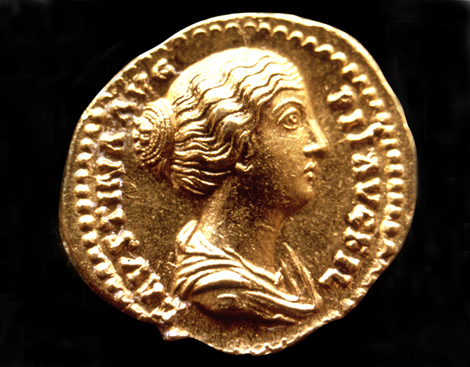 Forty-three years after being discovered at the bottom of the river Arade, the Roman gold coin classified as an “Aureus” by Faustina, from the 18nd century, returns to Portimão and its original historical context, to definitively integrate the collections of the Museum of Portimão, by order of the Secretary of State for Culture, published in the Diário da República this Monday, February XNUMXth.
Forty-three years after being discovered at the bottom of the river Arade, the Roman gold coin classified as an “Aureus” by Faustina, from the 18nd century, returns to Portimão and its original historical context, to definitively integrate the collections of the Museum of Portimão, by order of the Secretary of State for Culture, published in the Diário da República this Monday, February XNUMXth.
The coin was discovered in 1970, during the dredging process to create a rotation basin for ships calling at the port of Portimão, located in the estuary of the Arade river.
On October 23, 1970, the Diário de Noticias published the discovery “of two possibly Roman shipwrecks from the XNUMXnd century, in the port of Portimão” and the numerous remains brought to the surface, highlighted fragments of pottery, metal pieces and a coin of gold.
José Gameiro, director of the Portimão Museum, underlined in statements to the Sul Informação, that the return of the Roman gold coin to its origin was only possible due to the fact that the museological structure of the Algarve city is part of the Portuguese Museum Network and therefore has «appropriate conditions to house an object of this heritage value».
The official added that, after the completion of the bureaucratic incorporation process, the coin, considered to be an important testimony to the Roman presence and the archaeological and cultural heritage of this Municipality and the Algarve, will be integrated and exhibited in the exhibition “Portimão – Territory and Identity”. "Maybe we can have the coin here for the Museum's anniversary in May," he added.
This copy was the only one of its kind found in a set of a few thousand coins recovered as a result of those dredging works, together with many fragments of pottery and several pieces of metal, all this collection attesting to the important commercial movement that existed at the mouth of the Arade during the period of Roman influence.
Shortly after its discovery, the coin minted between 152 and 156 of our era in honor of Faustina Junior, wife of Emperor Marco Aurélio, was handed over by the then Junta Autónoma dos Portos do Barlavento Algarvio, responsible for the dredging works, to the guard of Caixa Geral de Depósitos, where he has remained until now.
Helder Mendes, filmmaker and amateur diver who made the first underwater footage of the archaeological remains found at the bottom of the Arade in the 70s, told the Sul Informação that the coin was found "by the Dutchman of the company of the same nationality hired by the Junta Autónoma de Portos to carry out the dredging"
Dredges, recalls Helder Mendes, “brought up several things, namely that coin, but also wood from old boats, fragments of pottery. The Dutchman, who was a cultured person with a vision, went to deliver the gold coin to the Junta dos Portos. From there, the news spread and people said that there was a treasure of gold coins at the bottom of the river Arade». But, as far as is known, only this little “Aureus” by Faustina is gold.
«We, that is, the Portuguese Federation of Underwater Activities, of which I was part, and the Portuguese Center for Underwater Activities, who were amateur divers, but already with a certain awareness of the value of heritage, went to the bottom of the river» .
Of the coin, Helder Mendes remembers that “a plaster model was made, so that it could be studied”.
The former diver and filmmaker, who is one of the few people who have ever seen the coin up close, considers the return of the Roman gold coin to Portimão “more than fair, it couldn't be otherwise”. «At Caixa Geral de Depósitos, where it had been since the 70s, coins did nothing. No one could see and admire it, no one could study it. Now, at the Portimão Museum, it is a heritage of all that can be enjoyed by all».
Junior Faustina (125-175)
Annia Galeria Faustina Minor, daughter of Emperor Antonino Pio and Faustina Senior, was the wife of Emperor Marco Aurélio, with whom she had 13 children, including Commodus, last Emperor of the Antonina Dynasty, and Lucilla, wife of Emperor Lucius Vero.
She accompanied her husband on his military campaigns, being quite popular and respected by soldiers. Marco Aurélio gave him the title of Mater Castrorum, the protector of the military camp.
In 175, in a military campaign in Cappadocia, Turkey, she suffered an accident that killed her. It was deified, and its statue placed in the Temple of Venus in Rome.
This gold coin, “aureus”, was minted between the years 152 and 156 of our era, during the lifetime of his father, Emperor Antonino Pio.
On the obverse, it shows Faustina's bust on the right, with her wavy hair caught on the nape of her neck; features the legend FAUSTINA AUG. P II AUG FIL, that is, Faustina Augusta Pia, daughter of Augusto, title held by the Emperor in course, Antonino Pio.
On the reverse, a dove walking, and the caption AGREE.



















Comments